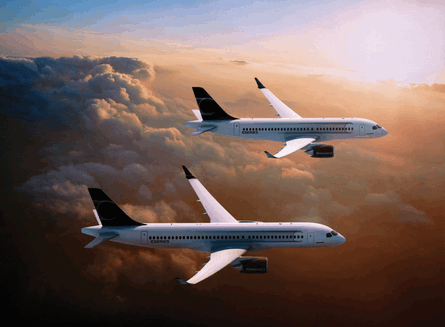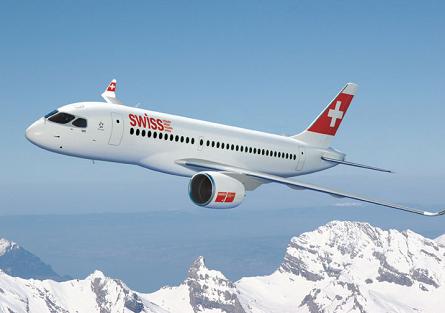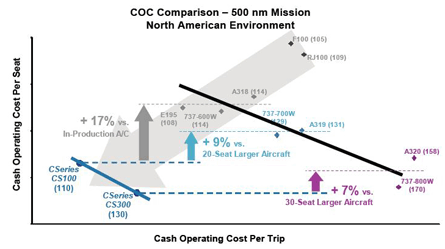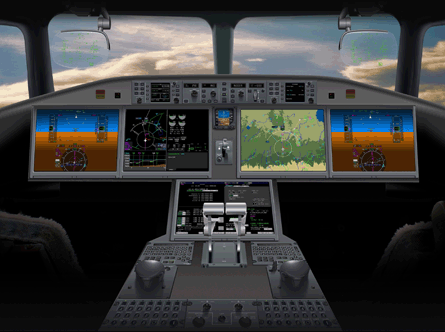At the beginning of this year Bombardier's long-discussed CSeries jetliner appeared at risk of being swallowed by the industry's brimming dustbin of paper airplanes.
Aerospace consultancy the Teal Group had already removed the Pratt & Whitney PurePower PW1500G-powered CSeries from its long-term forecast, saying the twinjet had less than a 50% chance of operating. And neither Airbus nor Boeing showed any signs of feeling pressure to respond to the 110/130-seat aircraft family by defining replacement plans for their highly successful A320 and 737 families.
Airbus's chief salesman John Leahy in January memorably exclaimed: "The market speaks for itself. Despite an awful lot of pushing, Bombardier has had a resounding failure to sell the CSeries, so we're not overly concerned by it commercially."
 |
|---|
© Bombardier |
But Bombardier was not ready to be counted out. Even after the Canadian manufacturer missed its self-imposed 31 January 2009 deadline to sign firm orders for the CSeries, the company continued to keep the faith on the five-abreast, small mainline airliner family that had evolved over a timeframe of several years - and endured a brief spell on the shelf - before gaining a level of credibility at last year's Farnborough air show where Lufthansa signed a letter of interest for up to 60 CSeries aircraft.
The airframer's seemingly endless well of patience was rewarded when, in March, Lufthansa's supervisory board approved a firm order for 30 C110 aircraft, which was simultaneously redesignated the CS100. Shortly after, Irish operating lessor Lease Corporation International (LCI) emerged as the second firm customer for the CSeries with a purchase agreement for 20 aircraft. The LCI deal, comprising three CS100s and 17 larger-capacity CS300s, was accompanied by options for an additional 20 aircraft.
This brought the total number of commitments for the CSeries to 100, prompted the Teal Group to reinstate the aircraft in its forecast - albeit an achievement obtained by the CSeries "by the skin of its teeth", says the consultancy - and finally hurled long-time regional aircraft manufacturer Bombardier into the mainline game.
MAINLINE CREDENTIALS
"Most of our discussions with regional operators still centre around our regional aircraft. Most discussions with mainline carriers centre around the CSeries," says Bombardier Commercial Aircraft president Gary Scott.
LCI's talks with potential customers for its 20-strong order mirrors Bombardier's experience. "We have been talking in some detail with legacy carriers and low-cost carriers in Europe and the Far East and we feel there are no shortage of potential customers for this aircraft," says LCI chief investment officer Tasos Michael, adding: "Some customers want a large number of aircraft, especially the low-cost carriers. Potentially, 20 might not be enough."
That is not to say that the CSeries will not also wear a regional jersey on the aviation field. Indeed, the first 20 CS100s heading for Lufthansa will be configured with 115 seats and are destined to replace the 20 BAE Systems Avro RJ100s operated by the German operator's subsidiary, Swiss International Air Lines, in its European regional division.
 |
|---|
© Bombardier |
Swiss will begin replacing the Avros in 2014 and says it expects the fleet roll-over to take just over two years. Another 10 CSeries twinjets will then be delivered to Swiss from 2016, which will permit further growth in the European operation.
But with Swiss and LCI earmarked to take their first CS100s in 2014, Bombardier has still to secure a customer that will launch the aircraft when it enters into service in 2013. Pulling in new orders amid a global economic recession is not an easy task. "Right now there is not a lot of ordering going on for any carrier, but they are very impressed with the product," says Scott, who believes the company can secure more CSeries orders by the end of the year.
Significantly, the airframer expects that 30% and perhaps as high as 40% of all CSeries orders will be placed by lessors. "We think the CSeries will be of considerable interest to leasing companies. That is different from regional jets, where we've seen a lot of sale/leaseback agreements but not a lot of lessor orders," says Bombardier Commercial Aircraft vice-president, marketing Philippe Poutissou, who attributes leasing companies' interest partly to the size of the CSeries "but also to the flexibility built into the aircraft".
FLEXIBLE PROPOSITION
The attributes that make the CSeries so flexible have been well reported. From New York Kennedy International airport, a CS100 carrying 110 passengers or a CS300 carrying 130 passengers has a range of 5,000km (2,700nm), making service to cities such as Vancouver, Los Angeles, Mexico City or Bogotá, achievable. Linking Frankfurt with Kano in Nigeria and Jeddah in Saudi Arabia, for example, is also within the aircraft's scope.
A recent change to the CSeries wing has improved short-field performance. As such, the CS100 will have a range of 2,780km from London City airport, easily serving the facility's existing destinations "while opening possibilities for new markets", says Bombardier commercial aircraft programmes vice-president Ben Boehm.
At its highest density, the CS100 can carry 125 passengers, while the CS300 can carry 145 passengers. Equally, "if you need a 100-seat, two-class aircraft, we have it", says Scott.
But several other attributes may set the CSeries apart from competitors. A total 70% of the aircraft will be made from advanced structure materials, including 46% advanced composites, which brings "significant weight savings", says Boehm.
Bombardier claims the aircraft will emit 20% less carbon dioxide and 50% less nitrous oxide, fly "four times quieter", and deliver 20% lower fuel burn with 15% better cash operating costs versus current similar-sized aircraft. It bases this claim on a 925km route "in a North American operating environment".
The aircraft will also boast a centralised maintenance health monitoring system. "We're still designing it, but if we get it right it will be accessible by maintenance technicians via personal digital assistants," says Boehm.
 |
|---|
Making good on these claims is now crucial for Bombardier, says Forecast International senior aerospace analyst Raymond Jaworowski. "A lot depends on whether the airliner's operational efficiencies play out. That is one of the considerations airlines look for. For Bombardier to be a big success with the CSeries, it will have to come close to meeting those."
Playing a substantial role in the CSeries' touted efficiencies is P&W's geared turbofan engine, now called the PurePower PW1000G. The 20,000-24,000lb thrust (89-107kN) class model, the PW1500G, will power the CSeries, while its sister, the lower-thrust PW1200G, will power Japan's new Mitsubishi MRJ regional jet.
In a conventional engine - called a "direct drive" because the shaft is connected between the two modules, the fan and the power turbine - there is a compromise made as to how slow the fan can be designed to improve efficiency. But, at the same time, as the turbine turns slower, there is a requirement for more aerofoils, or more stages in that turbine to extract the air to power that bigger fan.
"In the case of a geared engine, because we have this gear that allows us to change that relationship, for every one revolution that the fan makes, we actually have our low turbine or the powered turbine turning at three revolutions, and by doing that, we optimise the design of the turbine so that it becomes very efficient. But more importantly, because it's turning faster, we remove almost 1,000 aerofoils from the low turbine relative to a direct drive engine because the aerofoils are turning faster; there are less stages, less aerofoils to extract the work to be able to power the fan," P&W vice-president next generation product family Bob Saia told consultancy Innovation Analysis Group in a recent interview.
This, Saia explains, has a significant influence in lowering maintenance costs "well above what the industry can do today by just improving materials" and improving the "time on wing", the design time between engine servicing or engine overhaul.
TECHNOLOGY ROADMAP
While a 15% fuel burn improvement is being targeted for the CSeries' service entry in 2013, P&W's goal is to improve fuel consumption in the order of 1-1.5% a year. "So if we were to go from 2013 to 2018, we have set a target to have fuel reduction in 8-10% step change or improvement regime," says Saia.
This could prove both a blessing and a curse for Bombardier. On one hand, it ensures a technological roadmap for the CSeries. On the other hand, once the CSeries is in operation, Airbus and Boeing will have the ability to stand back, analyse its performance and determine their response. "Does that mean Boeing and Airbus take advantage of the next generation [engine] and that the CSeries is an interim product that looks good for four years?" asks Teal Group analysis vice-president Richard Aboulafia.
Thus far, the feathers of Airbus and Boeing have not been ruffled by any threat that the CSeries might pose to their incumbent single-aisle families. "I'm not losing any sleep over it," says Stuart Mann, who is director of A320 family product marketing. "The CSeries is a niche aircraft that competes at the bottom end of our market, and we can react commercially to it." Nor does either major airframer appear pressed to bring a new single-aisle replacement to market before the end of this decade.
Should Bombardier start snatching up significant orders for the CSeries, however, the quickest way for the major manufacturers to respond may be to take their existing products, put in some incremental improvements, and re-engine them.
At present, says Aboulafia, it "looks like Airbus has an advantage in terms of off-the-shelf re-engining" since its A320 family of aircraft can probably accommodate a new engine, such as a higher-thrust variant of the geared turbofan or the Leap X turbofan under development by CFM International, whereas "Boeing might have a problem with under-wing clearance".
Even so, Bombardier remains confident that its CSeries is the optimised aircraft solution for the 100- to 149-seat segment, and that this segment is territory that Airbus and Boeing are unlikely to pursue when defining their narrowbody replacement plans. "The airlines support our position that Boeing and Airbus will make a bigger single-aisle aircraft," says Bombardier's Scott.
If Airbus and Boeing decide on narrowbody successors using 150 seats as "the bottom rung", notes Forecast International's Jaworowski, they are "essentially relegating the under-150-seat market to Bombardier and Embraer".
BODY OF WORK
Bombardier is now busying itself with the task at hand, transitioning from what it calls the "joint conceptual definition phase" to the "joint definition phase" of the CSeries.
Boehm says 96% of all billable materials have already been contracted out for the CSeries. The remaining 4% constitutes "consumables and the flightdeck seats", under which Bombardier is considering adding a J-shaped track for "easier ingress and egress", says Boehm.
Shenyang Aircraft Corporation (SAC), a subsidiary of the state-owned aviation industrial entity China Aviation Industry Corporation (AVIC), will supply the centre fuselage on the CSeries aircraft.
 |
|---|
© Bombardier |
Aboulafia questions whether Bombardier made the right decision in choosing Shenyang to play such a substantial role in the CSeries programme. "The entire body of the plane with high-tech alloys is coming from these guys. You only need to look at the Shenyang web site to have enormous questions," he says.
But Jaworowski takes a less pessimistic view, noting that Bombardier "is a well-established aircraft manufacturer" that already has fruitful relationships with the Chinese. For example, the airframer has moved Q400 fuselage production from Japan to both China and its Belfast operation in the UK.
Belfast will develop and produce the CSeries' advanced composite wings. Alenia Aeronautica has been selected to provide the CSeries' horizontal and vertical stabilisers, while Fokker Elmo will be responsible for the design and production of the entire wiring and interconnection system. Goodrich Actuation Systems will supply the design and production of the flap and slat actuation systems.
Equipped with Rockwell Collins Pro Line Fusion avionics and featuring side-stick controllers, the CSeries flightdeck incorporates two high-definition, 15.1in (38cm) LCD screens in front of each pilot and one in the centre. Boehm says the five-screen display adds flexibility since revenue flights can still be flown with one failed display.
Other announced suppliers include interiors specialist C&D Zodiac; Parker Hannifin for design and production of the fully integrated fuel and hydraulics systems; and Liebherr-Aerospace Toulouse SAS for the design and production of the aircraft's air management system.
Bombardier is also studying wireless in-flight entertainment technology for the CSeries. "As we watch technology mature and as we listen to our customers we are starting to see a trend which would indicate that by 2013 a good portion of the common IFE systems (be that data, video, music, shopping, etc) could be transmitted 'wirelessly'," says Boehm.
NEXT PHASE
The CSeries will be produced at Bombardier's Mirabel plant, outside Montreal. In autumn the firm intends to break ground on the first CSeries building, a testing and training facility called the "complete integrated aircraft system test area" or CIASTA. The structure will house the first CSeries testbed aircraft, and will be built before a CSeries assembly plant is constructed nearby.
By the end of this year, Bombardier will have as many as 1,200 employees working on the CSeries. "So we have 250 more employees to hire this year," says Boehm. He says everything is on track for the CSeries to meet its 2013 service entry. "Nothing is changing on the CSeries timeline, despite the downturn."
Source: Flight Daily News























